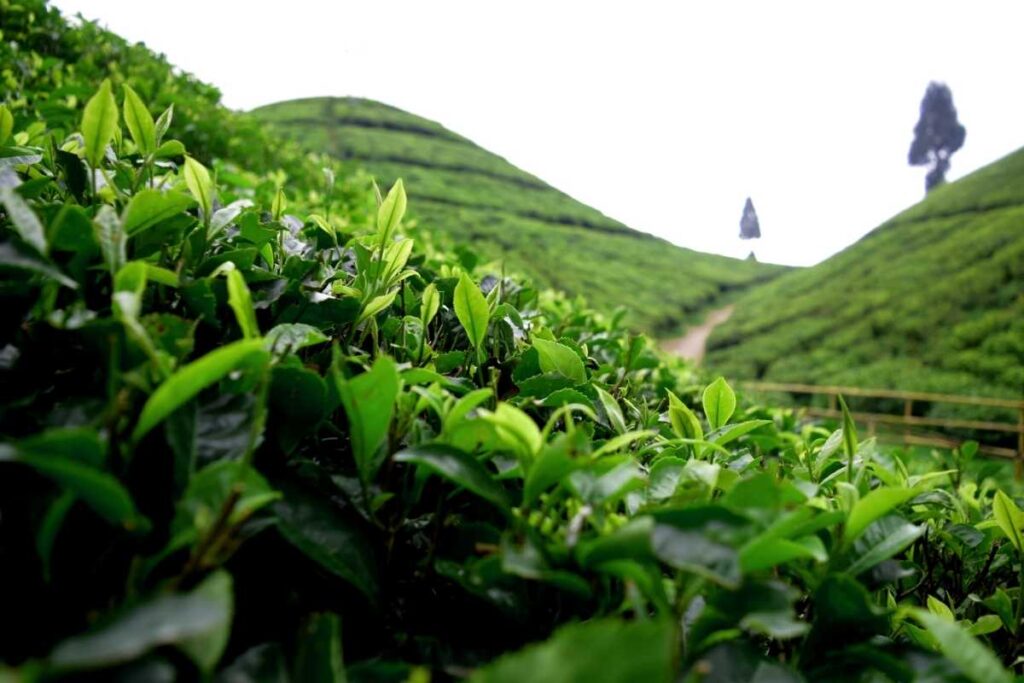Darjeeling Tea: Health Benefits and Buying Guide

Looking for a tea that’s more than just your average cuppa? Look no further than Darjeeling tea. This Indian gem hails from the Darjeeling region in the Darjeeling district and is known for its unique flavor and aroma. Whether you prefer black, white, or green teas, there’s something for everyone. And if you’re a true tea connoisseur, you won’t want to miss out on the highly sought-after first flush Darjeeling, harvested in the springtime from the flush Darjeeling tea estates. Additionally, if you’re looking to explore other Indian teas, consider trying Nilgiri tea made from the camellia sinensis var plant. For those who prefer coffee, loose leaf Darjeeling tea is a great alternative. So what can you expect from Darjeeling tea? Read on to find out!
What is Darjeeling Tea: Understanding the Varieties
Darjeeling tea, also known as the “champagne of teas,” is a popular type of loose leaf tea made from the Camellia Sinensis var plant in India. There are four main varieties of Darjeeling tea: black, green, white, and oolong. Each variety has a unique flavor profile and aroma due to differences in processing and harvesting. Nilgiri tea is another popular tea variety in India, but it is not related to Darjeeling tea or coffee.
Black Darjeeling Tea
Black Darjeeling tea, made from the leaves of the Camellia sinensis plant, is the most common variety and is known for its robust flavor and strong aroma. It is harvested during the second flush season (May-June) when the leaves have matured, providing a stronger taste. The leaves are fully oxidized before they are dried, giving them a deep reddish-brown color. For those who prefer lighter teas, white teas and oolong teas made from the same plant are also available in loose leaf form.
Green Darjeeling Tea
Green Darjeeling tea, derived from the camellia sinensis var plant, is less oxidized than black tea, resulting in a lighter color and milder taste. It is harvested during the first flush season (March-April) in Kalimpong, where the leaves are young and tender. The loose leaf undergoes minimal processing, retaining their natural green color. White teas are also available for those seeking a delicate and subtle flavor.
White Darjeeling Tea
White Darjeeling tea, made from the young buds of the camellia sinensis plant, still covered with fine white hair, undergoes minimal processing to preserve its natural appearance. It has a delicate flavor with floral notes and a pale yellow color. In addition to white tea, Darjeeling also produces black teas, known as flush teas, and is located in Kalimpong, India.
Oolong Darjeeling Tea
Oolong Darjeeling tea, made from Camellia sinensis leaves grown in the Kalimpong gardens, falls between black and green teas in terms of oxidation level. It has a complex flavor profile with fruity notes and floral undertones. The leaves are partially oxidized before drying to achieve this unique taste.
The Richness and Benefits of Darjeeling Tea: Highlighting Health Benefits
Darjeeling tea, one of the most popular black teas, is a type of tea that originates from the Darjeeling district in West Bengal, India. It is known for its unique flavor and aroma, which are derived from the region’s high altitude, cool climate, and soil conditions. The tea is produced from the Camellia sinensis plant grown in the famous tea gardens of Darjeeling and Kalimpong. But did you know that aside from its taste, Darjeeling tea also offers numerous health benefits? In this section, we’ll highlight some of the health benefits of drinking Darjeeling tea.
Packed with Antioxidants
One of the most significant health benefits of Darjeeling tea, a type of black tea from the Darjeeling district in India, is its high antioxidant content. Antioxidants are compounds that help protect our cells against damage caused by free radicals. Free radicals can cause oxidative stress in our bodies, which can lead to chronic diseases such as cancer and heart disease. Darjeeling tea is made from the Camellia sinensis plant and is known for its unique flush teas, which are harvested during specific times of the year.
By regularly drinking Darjeeling tea, which is grown in the gardens of India and made from the Camellia sinensis plant, you can increase your intake of antioxidants and reduce your risk of developing chronic diseases. Some studies have even shown that certain antioxidants found in Darjeeling flush teas may have anti-cancer properties.
Aids Digestion
Drinking hot water infused with Darjeeling tea, harvested from the Camellia sinensis plant in the gardens of India, can also aid in digestion and promote a healthy gut. The warm water helps to stimulate digestive enzymes, while the compounds found in the tea flush out toxins and soothe inflammation in the digestive tract.
If you suffer from indigestion or other digestive issues, try drinking a cup of hot water infused with Darjeeling tea, made from the Camellia sinensis plant in India’s West Bengal region, after meals to help ease discomfort. This tea is known for its distinct flush and may aid in digestion.
Improves Cardiovascular Health
White tea is a type of Darjeeling tea that originates from the first tea estates in West Bengal, India. It contains high levels of catechins – a type of antioxidant that has been shown to improve cardiovascular health. Catechins help to reduce inflammation in blood vessels and improve blood flow.
Regular consumption of white tea, especially from the Darjeeling region in West India, has been linked to lower blood pressure levels and reduced risk of heart disease. So if you’re looking for an easy way to improve your heart health, try adding some spring Darjeeling white tea to your daily routine.
Boosting Cardiovascular Health with Essential Antioxidants in Darjeeling Tea
Darjeeling tea, a popular beverage from West Bengal, India, is not just delicious and refreshing but also packed with powerful antioxidants that can help boost your cardiovascular health. These antioxidants are essential for reducing blood pressure, preventing cellular damage caused by free radicals, and improving blood flow. Additionally, Darjeeling tea is known for its unique flush, which adds to its distinct flavor and aroma.
Powerful Antioxidants in Darjeeling Tea
Darjeeling tea, which originated in the first tea estates of India’s Bengal region, is known for its high antioxidant content. The antioxidants, such as catechins and flavonoids, found in Darjeeling tea can protect the body from oxidative stress caused by free radicals. These free radicals are highly reactive molecules that can cause damage to cells and lead to chronic diseases like heart disease and stroke.
Lowering Blood Pressure
High blood pressure is a major risk factor for heart disease and stroke. Drinking Darjeeling tea from India’s Bengal estate regularly can help lower blood pressure due to its high levels of antioxidants. A study published in the British Journal of Nutrition found that drinking three cups of green tea per day reduced systolic blood pressure by an average of 2.6 mmHg.
Preventing Cellular Damage
The antioxidants in Darjeeling tea, grown in the Bengal region of India on a tea estate, can also help prevent cellular damage caused by free radicals. This damage can lead to chronic inflammation, which is linked to many diseases including heart disease and cancer. By neutralizing free radicals, the antioxidants in Darjeeling tea from this region can reduce inflammation and promote better overall health.
Anti-Stress Properties
Stress is another major risk factor for heart disease and stroke. The anti-stress properties of Darjeeling tea, which is grown in the Darjeeling district of West Bengal, India on a tea estate, can contribute to better cardiovascular health by reducing stress levels in the body. This is due to the presence of L-theanine, an amino acid that promotes relaxation without causing drowsiness.
Improving Blood Flow
The antioxidants in Darjeeling tea, which is grown in the Darjeeling district of West Bengal, India on various estates, can also improve blood flow throughout the body. This is because they help reduce oxidation in the body, which can lead to atherosclerosis, or the buildup of plaque in the arteries. By improving blood flow, Darjeeling tea from these estates in India can help reduce the risk of heart disease and stroke.
Facilitating Weight Loss with Darjeeling Tea: How it Works
Darjeeling tea, originating from the Bengal region of India, is a popular beverage known for its unique flavor and aroma. But did you know that this tea can also help you lose weight? Here’s how: Darjeeling tea is produced in various estates in the region, making it easily accessible to those looking to shed some pounds.
Catechins in Darjeeling Tea Aid in Weight Loss
One of the primary components of Darjeeling tea that contributes to weight loss is catechins. These are antioxidants found in abundance in the tea leaves of Bengal, India. According to research, catechins can help increase metabolism, which in turn leads to weight loss.
Catechins found in tea leaves work by inhibiting an enzyme called catechol-O-methyltransferase (COMT), which breaks down noradrenaline. Noradrenaline is a hormone responsible for breaking down fat cells and converting them into energy. By inhibiting COMT, catechins found in black tea and Indian tea leaf allow noradrenaline levels to remain high, leading to more fat being burned.
Caffeine Content Boosts Metabolism
Another way Darjeeling tea, which is grown in the Bengal region of India, helps with weight loss is through its caffeine content. Like other teas, Darjeeling contains caffeine, which acts as a stimulant and increases metabolic rate. This results in more calories being burned throughout the day, even when at rest.
Caffeine has been shown to suppress appetite and reduce cravings for sugary foods. By drinking Darjeeling tea, which is grown in the Indian state of West Bengal on tea estates, instead of reaching for unhealthy snacks or beverages, you can reduce your calorie intake and aid in weight loss.
Stress Reduction Can Contribute to Weight Loss
Stress is a common factor that contributes to weight gain. When stressed, the body releases cortisol, a hormone that triggers the storage of fat cells around the midsection area. However, consuming green tea, especially estate-grown tea leaves and oolong tea, has been found to potentially reduce stress levels and aid in weight loss.
Drinking Darjeeling tea from a reputable estate can help reduce stress levels due to its relaxing properties. The amino acid L-theanine found in the tea helps promote relaxation without causing drowsiness or fatigue.
By reducing stress levels and avoiding the storage of excess fat cells, Darjeeling tea can help facilitate weight loss.
Reducing the Risk of Parkinson’s Disease with Darjeeling Tea: Essential Compounds
Parkinson’s disease is a neurodegenerative disorder that affects millions of people worldwide. While there is no known cure for the disease, research has shown that certain compounds found in Darjeeling tea can help reduce the risk of developing Parkinson’s disease.
Caffeine Content
One of the key compounds found in Darjeeling tea that can help lower the risk of Parkinson’s disease is caffeine. Caffeine is a natural stimulant that helps to increase alertness and improve cognitive function. Studies have shown that caffeine may also have neuroprotective effects, which can help to reduce the risk of developing Parkinson’s disease.
Other Beneficial Compounds
The Camellia sinensis plant used to make Darjeeling tea contains other beneficial compounds that can also help reduce the risk of Parkinson’s disease. One such compound is polyphenols, which are antioxidants that help to protect cells from damage caused by free radicals. Free radicals are unstable molecules produced by our bodies as a result of normal metabolism and exposure to environmental toxins.
Another important compound found in Darjeeling tea is L-theanine, an amino acid that has been shown to have calming and relaxing effects on the brain. This can be particularly beneficial for individuals who are at risk for developing Parkinson’s disease, as stress has been identified as a potential risk factor for the disease.
Exploring the Spring, Summer, and Autumn Teas of Darjeeling: Flavor Profile and Seasons
Darjeeling tea is a unique beverage that offers a distinct muscatel flavor. This flavor is a result of the location of the tea gardens and the season in which the tea is harvested. In this article, we’ll explore the different types of Darjeeling teas available during each season and their flavor profiles.
Spring Teas: Flowery Aroma and Delicate Taste
Spring teas are harvested from late February to mid-April. These teas are known for their delicate taste and flowery aroma. The first flush or “Champagne” teas are highly sought after by tea connoisseurs for their unique flavor profile. The leaves used in spring teas are young and tender, resulting in a light-colored liquor with a subtle taste.
Summer Teas: Complex Flavor with Hints of Fruit and Spice
Summer teas are harvested from late May to June. These teas have a more complex flavor profile with hints of fruit and spice. The second flush or “Muscatel” teas are popular due to their unique musky aroma. The leaves used in summer teas are slightly matured compared to spring teas, resulting in a darker liquor with a stronger taste.
Autumnal Flush Teas: Bolder Taste with Muscatel Flavors
Autumnal flush teas are harvested from mid-September to November after the tea plants come out of their winter dormancy. These teas have a bolder taste with muscatel flavors similar to summer flush but less intense. The leaves used in autumnal flushes have been exposed to monsoon rains making them thicker than other seasons’ leaves, resulting in an amber-colored liquor.
Each season’s tea types offer different flavors that make Darjeeling tea versatile and sought-after worldwide. Tea gardens located at high altitudes produce some of the best quality Darjeeling teas. The tea gardens’ location, the season in which the tea is harvested, and the processing methods used all contribute to Darjeeling tea’s unique flavor profiles.
Brewing First Flush Spring Darjeeling Tea: Comprehensive Guide
In conclusion, Darjeeling tea is not just a regular cup of tea, but a health booster. With its rich flavor and essential antioxidants, it can help improve cardiovascular health and facilitate weight loss. Moreover, the essential compounds in Darjeeling tea have been found to reduce the risk of Parkinson’s disease.
Understanding the varieties of Darjeeling tea is crucial for brewing the perfect cup. The spring flush is highly sought after due to its delicate taste and aroma, followed by summer and autumn teas with their unique flavor profiles.
To fully enjoy the richness and benefits of Darjeeling tea, it is important to brew it correctly. By following our comprehensive guide on brewing first flush spring Darjeeling tea, you can experience its full potential.
So why not try brewing your own cup of green tea, oolong tea, or black tea using high-quality tea leaves today? Not only will you be indulging in a delicious beverage but also reaping its numerous health benefits. Cheers to good health!




